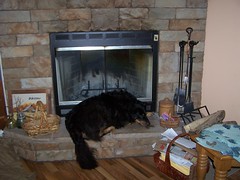I started by sanding both sides of the panels. The plywood backer did not get as much attention as the oak side, but it did get sanded smooth. The oak side got sanded to the finish stage.
 After sanding I took the panels into the finishing room and shot the edges with lacquer. There are two reasons for doing this. One concerns the fact that the solid wood ribbon panel will expand and contract with changes in the humidity. It's been raining yesterday and today, so it will be expanded. Finishing the long grain edges insures that after assembly if the panel contracts (and it will) an unfinished stripe of wood will not emerge from the groove in the tray rail. That would be unsightly. The other reason for finishing the corners is to help prevent glue from bonding the corners of the ribbon panel to the corners of the rails.
After sanding I took the panels into the finishing room and shot the edges with lacquer. There are two reasons for doing this. One concerns the fact that the solid wood ribbon panel will expand and contract with changes in the humidity. It's been raining yesterday and today, so it will be expanded. Finishing the long grain edges insures that after assembly if the panel contracts (and it will) an unfinished stripe of wood will not emerge from the groove in the tray rail. That would be unsightly. The other reason for finishing the corners is to help prevent glue from bonding the corners of the ribbon panel to the corners of the rails. While the lacquer dries I sand and begin assembly of the stand. I'll continue working on this any time I've got down time in building the trays.
While the lacquer dries I sand and begin assembly of the stand. I'll continue working on this any time I've got down time in building the trays.To cut the tray rails I install a jig that serves as a backer to prevent tearing out the back side of the rail stock as I cut the miter joints and it is calibrated with the exact length each rail needs to be for a perfect fit. As long as I got the tray panels the right size there should be no tedious paring away at over length rails to sneak up on a proper fit,
The rails are cut from long strips of stock and each piece is cut sequentially so the grain in the wood wraps around the corners in a most wonderful way. I hold the corners together with masking tape and check for a precise fit at all corners and to the panel.
Once I'm satisfied with the fit I take each rail piece loose so I can apply just the right amount of glue to just the right places and slip the rail back into place. The tape helps hold everything in place as I work.
When all the pieces are glued I apply clamps to firmly hols the pieces in place. I'll leave these in place overnight to allow the glue to achieve maximum hold before I work with them further.
In the mean time I finish assembling the stand.
I also shape and assemble the latch blocks. These parts will hold the tray table legs in teh open position while the tables are in use. I should probably try to patent these, they're really quite clever.
One last chore before the girls and I head home for some Chinese food and a schlocky Sci-Fi movie (our standard Friday evening fare) is to make up a mess of plugs that will be glued in over the recessed screws to hide them. I use scraps from the table to the color matches well.
And that's going to do it for the day and the week. next week I'll do the final assembly by jointing the trays to the bases, plug the screw holes and do the finish sanding. Then all that's left to do is to apply the finish and they'll be ready to box up so they can ship out as soon as they're purchased.









































